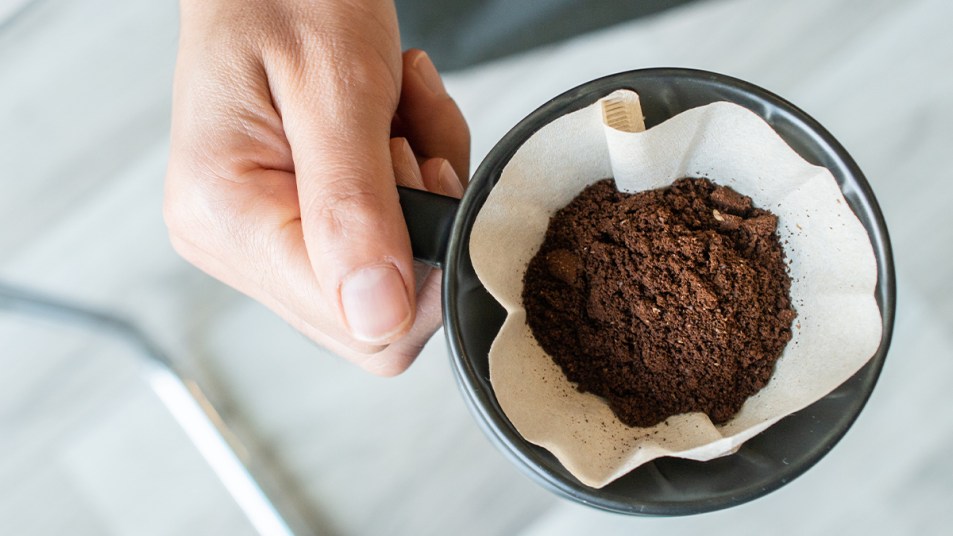Don’t Throw Away Used Coffee Grounds! They Can Help Your Garden Thrive This Spring

After brewing a delicious cup of coffee in the morning, we tend to think that the leftover grounds have done their job and can go in the trash. But, they’re a gold mine for helping your houseplants and garden thrive!
Coffee and plants might seem like polar opposites, but research published in the journal Trends in Food Science & Technology found that used coffee grounds contain a lot of organic compounds like fatty acids, amino acids, polyphenols, and minerals — all of which can provide your plants with nutrients to become vibrant and healthy.
Of course, there’s a variety of plant vitamins and other nutrient boosters that you can pick up from your local gardening supplies store to do this. But using the leftover grounds from your morning cup of joe is much cheaper. And, you don’t even have to use the grounds right away. They’ll last for up to one to two years if you follow Wikihow‘s hack for scooping the used coffee grounds into a clean, airtight mason jar, placing a tiny square of newspaper on top of the jar (to absorb any excess moisture), and then securing the lid. Be sure to store them in a cool, dry place and check it every month or two to make sure there isn’t any liquid building up in the jar.
With a pretty long shelf life, it’s a clear winner for your gardening needs all year round. So here are some ways to use coffee grounds for your plants to enhance their growth and vitality!
How to Use Coffee Grounds as Mulch and Fertilizer
Mulch helps control weeds around your plants by blocking sunlight under the soil while still retaining the moisture. Plus, for an outdoor garden, it gives it a more finished, neat look! Although you can buy a bag of mulch at a gardening supplies store, coffee grounds work just as well because they’re easy to keep tucked away in a jar and they’re organic and will gradually decompose as needed.
However, due its acidic and caffeinated nature, the experts at Indoor Home Garden suggest combining the grounds with other organic materials like compost or leaf molds beforehand to balance out the pH level of the soil. Then it’s ready to spread on top of the soil in a two to three inch-thick layer. Make sure that you don’t put too much mulch on top so water can still reach down into the soil.
You can get more of IHG‘s tips for using coffee grounds in your gardening kit here:
Your coffee grounds can go a long way to help maintain your plants’ well-being for months to come! For indoor plants, you can try mixing the grounds with your regular potting material when you’re repotting the plant to act as a slow-release fertilizer. This will provide the plants with a steady source of nutrients for up to six months because of the coffee’s high nitrogen content.
Mix Grounds Into Your Compost Pile
Think of compost as your soil’s best friend: It acts as a support system by providing nutrients and nitrogen when needed, and it’ll prevent any harmful fungi from growing on the surface. Adding in coffee grounds to the mix can actually enhance this partnership as research has shown that it boosts the amount of nutrients present in the compost!
Rather than just guessing how much you should add into your compost pile, the experts at Gardeners.com recommend a ratio of three parts brown materials, like corn cobs, pine needles, or vegetable stalks, to one part of green materials, which in this case would be coffee grounds — but eggshells would work, too. A few rules of thumb they suggest are to layer these ingredients in a compost bin (Buy at Walmart, $14.99), turn the pile from time to time so that it gets a good amount of oxygen exposure, and keep the mixture damp like a well-wrung sponge.
Now you have a DIY compost pile ready to use to maintain the strength and health of your plants during each season of the year.
How Coffee Grounds Keep Insects and Pests Away
If you can’t keep little creatures like insects, slugs, and snails out of your garden, then have your coffee grounds on hand to eliminate your gardening woes! The caffeine still left in the grounds is potent enough to act as an insecticide and drive pests away. Also, this is an all-natural way to protect your houseplants and garden without any harsh chemicals needed.
Simply scatter a handful of your coffee ground mix around your plants to create a barrier that’ll shoo away pests like slugs and snails because they won’t want to crawl over it. If you love enjoying an afternoon in your backyard insect-free, Healthline suggests putting the grounds in bowls and placing them around your outdoor seating areas to repel any unwanted guests like mosquitos, fruit flies, and beetles.
Repurposing leftover coffee grounds for your plants is a game changer whether you’re just learning the basics or have been gardening for years!
















